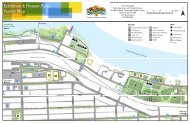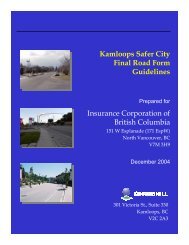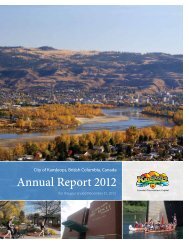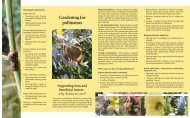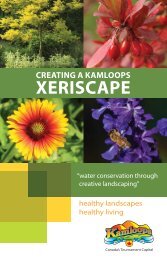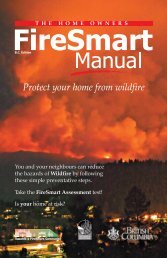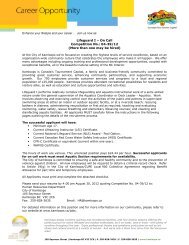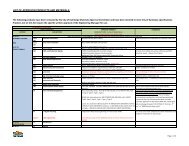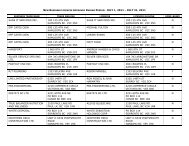Planting the seeds for a sustainable future - City of Kamloops
Planting the seeds for a sustainable future - City of Kamloops
Planting the seeds for a sustainable future - City of Kamloops
Create successful ePaper yourself
Turn your PDF publications into a flip-book with our unique Google optimized e-Paper software.
Ranching and Dryland Production in <strong>Kamloops</strong> (Map 5)Table 2Ranching and Dryland Production in <strong>Kamloops</strong>Crown Land Under Grazing Lease2,598 haRANGE: is any land supporting vegetation thatcan be consumed by both domestic livestockand wildlife and is managed as a naturalecosystem.Crown Land under Grazing TenureVacant Crown LandAdditional Land deemed suitable <strong>for</strong> dryland production3,855 ha4,271 ha4,798 haRanching is <strong>the</strong> production <strong>of</strong> beef cattle that are allowed to graze onrangelands during <strong>the</strong> spring, summer, and fall. Rangelands includepastures, grasslands, and <strong>for</strong>ested areas and may be both privately andpublicly owned. Ranching takes place primarily in <strong>the</strong> Interior region <strong>of</strong>British Columbia where rangeland is available.Map 5 identifies existing rangeland within <strong>the</strong> <strong>City</strong> on Crown land and privateland. Ranchers using Crown land <strong>for</strong> range purposes can ei<strong>the</strong>r lease <strong>the</strong>land or enter into a tenure with <strong>the</strong> province. The majority <strong>of</strong> ranching anddryland production in <strong>the</strong> <strong>Kamloops</strong> area occurs in <strong>the</strong> sou<strong>the</strong>rn portion <strong>of</strong> <strong>the</strong><strong>City</strong> and along <strong>the</strong> political boundaries <strong>of</strong> <strong>the</strong> <strong>City</strong>.The amount <strong>of</strong> <strong>for</strong>age produced annually on rangeland is difficult to predictand is highly dependent on climate, soil, elevation, latitude, and topographicconditions. Currently, BC Crown range produces about 900,000 Animal UnitMonths per year. An Animal Unit Month is defined as <strong>the</strong> amount <strong>of</strong> <strong>for</strong>agethat is required <strong>for</strong> one month by an average cow aged six months or older.Rangelands are ei<strong>the</strong>r owned privately or by<strong>the</strong> Crown and are managed to supply <strong>for</strong>age<strong>for</strong> both livestock and wildlife.Without range land, ranchers likely could notoperate economically. Range provides feed <strong>for</strong>cattle between six to eight months <strong>of</strong> <strong>the</strong> year.Ranchers can <strong>the</strong>n use <strong>the</strong>ir more productivelands to produce winter feed (hay).The Grasslands Council <strong>of</strong> British Columbiaworks with land managers to achieve<strong>sustainable</strong> management practices and toimplement proactive projects that will ensure<strong>the</strong> conservation and stewardship <strong>of</strong> BC'sgrasslands. For more in<strong>for</strong>mation visit:www.bcgrasslands.org.CITY OF KAMLOOPS 19




